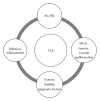Natural history of temporal lobe epilepsy: antecedents and progression
- PMID: 22937237
- PMCID: PMC3420774
- DOI: 10.1155/2012/195073
Natural history of temporal lobe epilepsy: antecedents and progression
Abstract
Temporal lobe epilepsy represents the largest group of patients with treatment resistant/medically intractable epilepsy undergoing epilepsy surgery. The underpinnings of common forms of TLE in many instances begin in early life with the occurrence of an initial precipitating event. The first epileptic seizure often occurs after a variable latency period following this event. The precise natural history and progression following the first seizure to the development of TLE, its subsequent resolution through spontaneous remission or the development of treatment resistant epilepsy remain poorly understood. Our present understanding of the role played by these initial events, the subsequent latency to development of temporal lobe epilepsy, and the emergence of treatment resistance remains incomplete. A critical analysis of published data suggest that TLE is a heterogeneous condition, where the age of onset, presence or absence of a lesion on neuroimaging, the initial precipitating event, association with febrile seizures, febrile status epilepticus, and neurotropic viral infections influence the natural history and outcome. The pathways and processes through which these variables coalesce into a framework will provide the basis for an understanding of the natural history of TLE. The questions raised need to be addressed in future prospective and longitudinal observational studies.
Figures
Similar articles
-
New-onset temporal lobe epilepsy in children: lesion on MRI predicts poor seizure outcome.Neurology. 2006 Dec 26;67(12):2147-53. doi: 10.1212/01.wnl.0000248189.93630.4f. Epub 2006 Nov 2. Neurology. 2006. PMID: 17082466 Clinical Trial.
-
Do recurrent seizures cause neuronal damage? A series of studies with MRI volumetry in adults with partial epilepsy.Prog Brain Res. 2002;135:279-95. doi: 10.1016/S0079-6123(02)35026-X. Prog Brain Res. 2002. PMID: 12143348
-
Temporal lobe epilepsy in childhood: clinical, EEG, and neuroimaging findings and syndrome classification in a cohort with new-onset seizures.Neurology. 1997 Oct;49(4):960-8. doi: 10.1212/wnl.49.4.960. Neurology. 1997. PMID: 9339674
-
Current management and surgical outcomes of medically intractable epilepsy.Clin Neurol Neurosurg. 2013 Dec;115(12):2411-8. doi: 10.1016/j.clineuro.2013.09.035. Epub 2013 Oct 11. Clin Neurol Neurosurg. 2013. PMID: 24169149 Review.
-
Molecular neuropathology of temporal lobe epilepsy: complementary approaches in animal models and human disease tissue.Epilepsia. 2007;48 Suppl 2:4-12. doi: 10.1111/j.1528-1167.2007.01062.x. Epilepsia. 2007. PMID: 17571348 Review.
Cited by
-
Comparison of temporal lobe epilepsy with hippocampal sclerosis and temporal lobe epilepsies due to other etiologies.Med J Islam Repub Iran. 2015 Sep 13;29:263. eCollection 2015. Med J Islam Repub Iran. 2015. PMID: 26793654 Free PMC article.
-
Clinical characteristics of patients with benign nonlesional temporal lobe epilepsy.Neuropsychiatr Dis Treat. 2016 Jul 28;12:1887-91. doi: 10.2147/NDT.S110400. eCollection 2016. Neuropsychiatr Dis Treat. 2016. PMID: 27555776 Free PMC article.
-
Longitudinal changes of focal cortical glucose hypometabolism in adults with chronic drug resistant temporal lobe epilepsy.Brain Imaging Behav. 2021 Dec;15(6):2795-2803. doi: 10.1007/s11682-021-00576-8. Epub 2021 Oct 20. Brain Imaging Behav. 2021. PMID: 34671889
-
The effect of STAT3 inhibition on status epilepticus and subsequent spontaneous seizures in the pilocarpine model of acquired epilepsy.Neurobiol Dis. 2014 Feb;62:73-85. doi: 10.1016/j.nbd.2013.09.003. Epub 2013 Sep 16. Neurobiol Dis. 2014. PMID: 24051278 Free PMC article.
-
Early Gabapentin Treatment during the Latency Period Increases Convulsive Threshold, Reduces Microglial Activation and Macrophage Infiltration in the Lithium-Pilocarpine Model of Epilepsy.Pharmaceuticals (Basel). 2017 Nov 28;10(4):93. doi: 10.3390/ph10040093. Pharmaceuticals (Basel). 2017. PMID: 29182533 Free PMC article.
References
-
- Gastaut H, Gastaut JL, Goncalves Silva EGE, Fernandez Sanchez GR. Relative frequency of different types of epilepsy: a study employing the classification of the international league against epilepsy. Epilepsia. 1975;16(3):457–461. - PubMed
-
- Manford M, Hart YM, Sander JW, Shorvon SD. National general practice study of epilepsy (NGPSE): partial seizure patterns in a general population. Neurology. 1992;42(10):1911–1917. - PubMed
-
- Ottman R. Genetics of the partial epilepsies: a review. Epilepsia. 1989;30(1):107–111. - PubMed
-
- Engel J., Jr. Introduction to temporal lobe epilepsy. Epilepsy Research. 1996;26(1):141–150. - PubMed
-
- Spencer S. Mesial temporal sclerosis: electroclinical and pathophysiological correlations and application to limbic epilepsy in childhood. In: Munari GA, Beaumanoir A, Mira L, editors. Limbic Seizures in Children. Eastleigh, UK: John Libbey; 2001.
LinkOut - more resources
Full Text Sources

